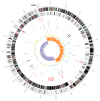The Phylogeny, Metabolic Potentials, and Environmental Adaptation of an Anaerobe, Abyssisolibacter sp. M8S5, Isolated from Cold Seep Sediments of the South China Sea
- PMID: 37764000
- PMCID: PMC10536192
- DOI: 10.3390/microorganisms11092156
The Phylogeny, Metabolic Potentials, and Environmental Adaptation of an Anaerobe, Abyssisolibacter sp. M8S5, Isolated from Cold Seep Sediments of the South China Sea
Abstract
Bacillota are widely distributed in various environments, owing to their versatile metabolic capabilities and remarkable adaptation strategies. Recent studies reported that Bacillota species were highly enriched in cold seep sediments, but their metabolic capabilities, ecological functions, and adaption mechanisms in the cold seep habitats remained obscure. In this study, we conducted a systematic analysis of the complete genome of a novel Bacillota bacterium strain M8S5, which we isolated from cold seep sediments of the South China Sea at a depth of 1151 m. Phylogenetically, strain M8S5 was affiliated with the genus Abyssisolibacter within the phylum Bacillota. Metabolically, M8S5 is predicted to utilize various carbon and nitrogen sources, including chitin, cellulose, peptide/oligopeptide, amino acids, ethanolamine, and spermidine/putrescine. The pathways of histidine and proline biosynthesis were largely incomplete in strain M8S5, implying that its survival strictly depends on histidine- and proline-related organic matter enriched in the cold seep ecosystems. On the other hand, strain M8S5 contained the genes encoding a variety of extracellular peptidases, e.g., the S8, S11, and C25 families, suggesting its capabilities for extracellular protein degradation. Moreover, we identified a series of anaerobic respiratory genes, such as glycine reductase genes, in strain M8S5, which may allow it to survive in the anaerobic sediments of cold seep environments. Many genes associated with osmoprotectants (e.g., glycine betaine, proline, and trehalose), transporters, molecular chaperones, and reactive oxygen species-scavenging proteins as well as spore formation may contribute to its high-pressure and low-temperature adaptations. These findings regarding the versatile metabolic potentials and multiple adaptation strategies of strain M8S5 will expand our understanding of the Bacillota species in cold seep sediments and their potential roles in the biogeochemical cycling of deep marine ecosystems.
Keywords: Abyssisolibacter sp. M8S5; Bacillota; adaption genomic analysis; cold seep; metabolic potentials.
Conflict of interest statement
The authors declare no conflict of interest.
Figures





Similar articles
-
Genomic Analysis of the Deep-Sea Bacterium Shewanella sp. MTB7 Reveals Backgrounds Related to Its Deep-Sea Environment Adaptation.Microorganisms. 2023 Mar 21;11(3):798. doi: 10.3390/microorganisms11030798. Microorganisms. 2023. PMID: 36985371 Free PMC article.
-
Genomic characterization of the bacterial phylum Candidatus Effluviviacota, a cosmopolitan member of the global seep microbiome.mBio. 2024 Aug 14;15(8):e0099224. doi: 10.1128/mbio.00992-24. Epub 2024 Jul 9. mBio. 2024. PMID: 38980039 Free PMC article.
-
Bacteria and Archaea Synergistically Convert Glycine Betaine to Biogenic Methane in the Formosa Cold Seep of the South China Sea.mSystems. 2021 Oct 26;6(5):e0070321. doi: 10.1128/mSystems.00703-21. Epub 2021 Sep 7. mSystems. 2021. PMID: 34491083 Free PMC article.
-
Cold seep nitrogen fixation and its potential relationship with sulfur cycling.Microbiol Spectr. 2024 Oct 3;12(10):e0053624. doi: 10.1128/spectrum.00536-24. Epub 2024 Aug 22. Microbiol Spectr. 2024. PMID: 39171911 Free PMC article.
-
Unexpected genetic and microbial diversity for arsenic cycling in deep sea cold seep sediments.NPJ Biofilms Microbiomes. 2023 Mar 29;9(1):13. doi: 10.1038/s41522-023-00382-8. NPJ Biofilms Microbiomes. 2023. PMID: 36991068 Free PMC article. Review.
Cited by
-
Genomic and physiological properties of Anoxybacterium hadale gen. nov. sp. nov. reveal the important role of dissolved organic sulfur in microbial metabolism in hadal ecosystems.Front Microbiol. 2024 Aug 16;15:1423245. doi: 10.3389/fmicb.2024.1423245. eCollection 2024. Front Microbiol. 2024. PMID: 39220043 Free PMC article.
References
-
- Wang X., Guan H., Qiu J.-W., Xu T., Peckmann J., Chen D., Feng D. Macro-ecology of cold seeps in the South China Sea. Geosyst. Geoenviron. 2022;1:100081. doi: 10.1016/j.geogeo.2022.100081. - DOI
-
- Feng D., Qiu J.-W., Hu Y., Peckmann J., Guan H., Tong H., Chen C., Chen J., Gong S., Li N., et al. Cold seep systems in the South China Sea: An overview. J. Asian Earth Sci. 2018;168:3–16. doi: 10.1016/j.jseaes.2018.09.021. - DOI
-
- Dong X., Rattray J.E., Campbell D.C., Webb J., Chakraborty A., Adebayo O., Matthews S., Li C., Fowler M., Morrison N.M., et al. Thermogenic hydrocarbon biodegradation by diverse depth-stratified microbial populations at a Scotian Basin cold seep. Nat. Commun. 2020;11:5825. doi: 10.1038/s41467-020-19648-2. - DOI - PMC - PubMed
Grants and funding
LinkOut - more resources
Full Text Sources

